工具:ImageJ
Tool: ImageJ
待分析图样:STEM Pt合金花样
Pattern: STEM or Pt-alloy catalyst
在分析纳米颗粒的结构的时候,有时候会用到STEM。可以直观的看到晶面间距,标定晶面间距以后,就可以根据d值确定hkl值。以下图为例。
STEM is commonly used for measure the d value of the different facets to confirm the crystalline structure. The example is shown in beneath:
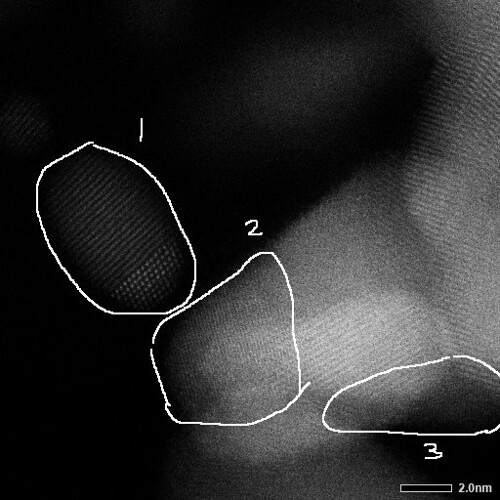
1号区域内的间距很容易测定,因为晶面清晰,可以测定多个晶面的间距,除以数目,简单算出d值。那么,2、3区域,虽然肉眼可见花样,但是很难数清楚,并且一旦放大像素就会失真。
The d value in 1 area is easy to be observed. Measure distance between ten or more line ,and then divide by the number of lines, d value of each two facets is calculated out. However, in area 2 and 3, it’s difficult for the low dissolution and crowed lines.
所以采用如下方式处理:
1.选定区域,矩形选框或者自由线条都可以
2.imageJ的菜单栏-Process-FFT-FFT 变换
FFT变换的意思是图样在某个方向上有一个sin函数的亮度变化,一个周期,那么,就会有个亮点正好出现在中间。所以四周亮点到中心的距离代表了这个方向上的波数。选定区域以后,计算机会自动将区域转化为2^n PIX 的正方形,然后计算。imageJ确定两个亮点的间距(中点必经过中心点),得到一共是n个像素(PIX),用正方形的边长a除以n就得到了一个周期是a/n,即一个明条纹和一个暗条纹的长度是a/n个像素,即d
再用比例尺转化就可以知道d是多少nm。
We can deal with these areas like this:
1.Choose the area by rectangle or free hand selection.
2.menu-Process-FFT
Calculate the distance of two central symmetric white dots, divided by two, we got the value n (PIX). We can get the wavelength of this dark and bright pattern in this orientation. In another word, d=a/n (a is the PIX number of the FFT square’s side length), here, the unit of d is “PIX”. we can turn it into “nm” by scale.
例如这张图2区域经过FFT变换:
Here is FFT square picture of the 2 area:
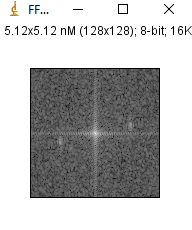
测周围的白点到中心点的距离。
Measure the distance of white dot to the middle dot.
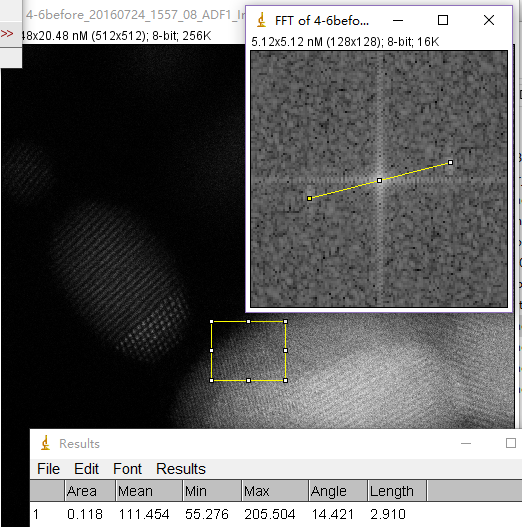
2.910/2
区域面积5.12nm*5.12nm
用边长除,得到波长:5.12/(2.910/2) pix
比例尺是50pix=2nm
所以 (5.12/(2.910/2))/50*2= 0.141nm
比对Pt 的PDF卡片
2.910 nm/2
side length of the FFT is 5.12 nm
wave length: 5.12/(2.910/2) pix
scale: 50pix=2nm
so, d=(5.12/(2.910/2))/50*2= 0.141nm
check Pt PDF card:
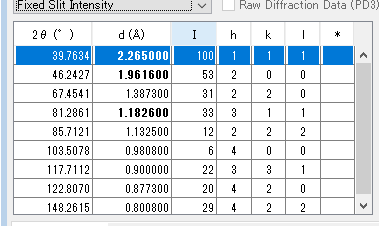
比较接近(220)晶面的0.13873 nm,所以这个部位是(220)晶面。
It’s close to (220), 0.13873 nm. So it’s (220)facet.
关于各种晶体的3D模型,可以在atom work注册以后下载。需要用软件VESTA查看。使用veiw lattice plane功能可以指定hkl看晶面。也可以计算晶面夹角。
为什么要写这个?因为我昨天数条纹数的眼睛都瞎了。今天从助教那里学会了怕忘记。以及,来自一个菜鸟善意的提示,如果有其他新手也要处理STEM花样希望有用。
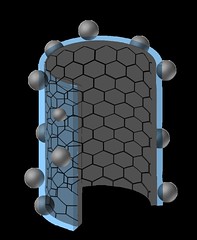

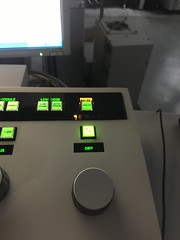
2 条评论
就喜欢女博士的专业劲儿
谢谢